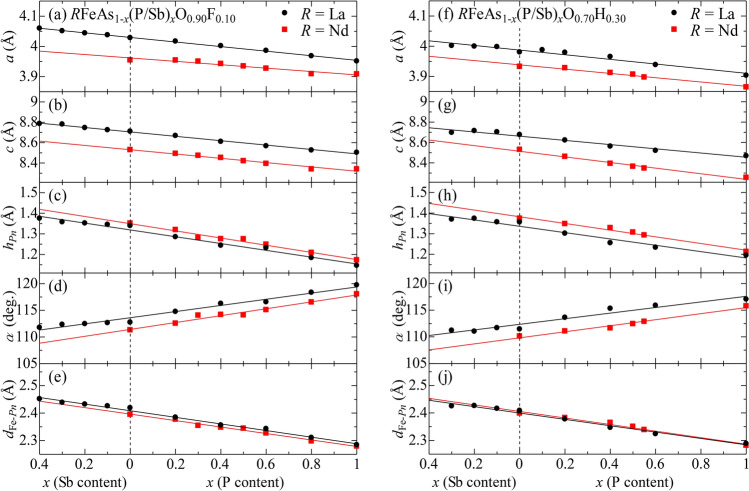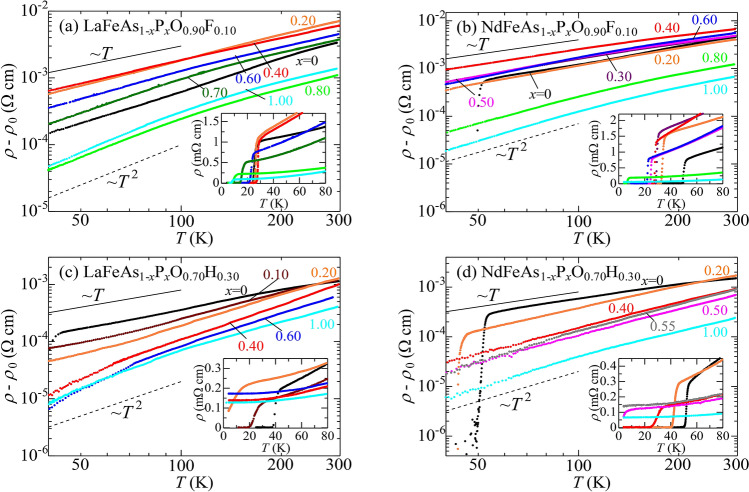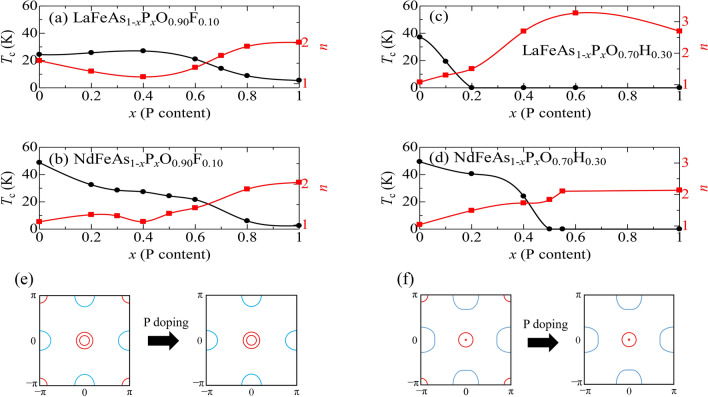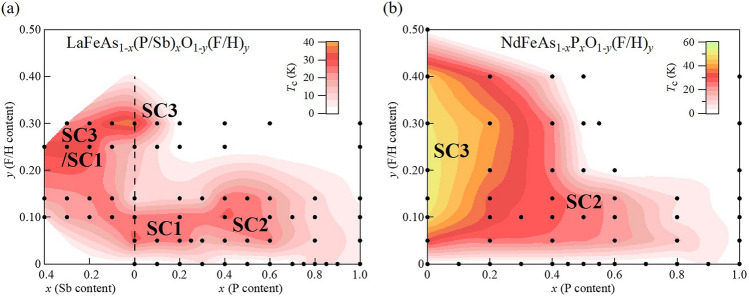Abstract
The structural flexibility at three substitution sites in LaFeAsO enabled investigation of the relation between superconductivity and structural parameters over a wide range of crystal compositions. Substitutions of Nd for La, Sb or P for As, and F or H for O were performed. All these substitutions modify the local structural parameters, while the F/H-substitution also changes band filling. It was found that the superconducting transition temperature is strongly affected by the pnictogen height from the Fe-plane that controls the electron correlation strength and the size of the hole Fermi surface (FS). With increasing , weak coupling BCS superconductivity switches to the strong coupling non-BCS one where electron correlations and the hole FS may be important.
Subject terms: Electronic properties and materials, Superconducting properties and materials
Introduction
Identifying the mechanism of high-temperature superconductivity has been a challenging task in solid state physics. For iron pnictide superconductors1,2, more than 10 years’ effort has been devoted to clarifying the superconductivity mechanism. However, the essential problem of a pairing glue is still under debate. In many iron-based superconductors, the superconducting phase is observed near the quantum critical point of magnetic order3 and/or nematic order4. This suggests a spin or orbital fluctuation as pairing glue. On the other hand, the Fermi surface (FS) topology of iron-based superconductors has a strong material dependence5–15, which causes difficulties in clarifying the superconducting mechanism from the viewpoints of FS nesting related with the spin or orbital fluctuation. Instead of FS nesting approach, a lot of other theoretical models have been proposed to explain their superconducting mechanism16–23. One of these proposals emphasizes strong electron correlation near the Mott insulator regime16–18, rather than a magnetic or orbital fluctuation in the weak-coupling regime.
Experimentally, it is well known that there is a correlation between the superconducting transition temperature () and local crystal structure parameters, such as the pnictogen height () from the Fe-layer, and the As–Fe–As bond angle (). First, Lee et al. demonstrated that reaches a maximum when is close to 109.47, corresponding to the value for a regular FeAs tetrahedron24. A similar correlation was found between and 25. Here the maximum was observed at Å . The main questions are: which physical parameters are controlled by these structural parameters, and how do they contribute to superconductivity?
According to theoretical calculations, the hole FS around in the unfolded Brillouin zone expands with increasing 26. However, it is not obvious how this electronic change controls superconductivity. In fact, in the LaFeAsO (La-1111) system, does not vary monotonically with changes in lattice parameters27–29. Our previous studies have revealed that there are three superconducting phases in LaFe(As,P)(O,F/H), depending on the compositions29. Although bosonic fluctuation via FS nesting was discussed as the most plausible pairing mechanism, the high in the third superconducting phase (SC3) could not be explained using the same scenario, because the nesting condition is very bad. Here it is unclear which structural parameter switches the mechanism, and how. As an alternative to the FS nesting based weak-coupling model, it is worth examining other scenario based on strong electron correlation near the Mott insulator regime16,18. Here it is unclear which structural parameter switches the mechanism, and how.
In this study, we extended our previous work on LaFe(As,P)(O,F/H)29 by covering a wider range of structural parameters through three site substitutions (Nd for La, Sb or P for As, and F or H for O). All these substitutions modify the local structural parameters, while the F/H-substitution also changes band filling. (In other iron-based superconductors, AFe2As2 systems (A = Ba, Sr, and Ca), the phase diagrams and Tc have been investigated from the viewpoints of local structural parameters and carrier doping level30.) Precise measurements of structural parameters and resistivity for all samples revealed that the hole FS is crucially important in a wide doping range for the high compounds. Although there are apparently three SC phases, two of them (SC1 and SC3) turn out to be of the same origin. It is likely that with increasing electron correlation becomes strong, which switches the FS nesting based weak coupling superconductivity (SC2) to other type of superconductivity such as the one derived from orbital-selective Mott systems (SC1/SC3). T-linear resistivity was commonly observed near the -maximum composition in each phase.
Results
First, we present structural data for several typical compositions. (Data for all remaining compositions are provided in the “Supplementary Information”.) Figure 1a,b,f,g show the lattice constants a and c as functions of P/Sb content (x) for RFeAs(P/Sb)O(F/H) with and 0.3 (R = La and Nd). Part of the dataset is taken from our previous papers27–29. The P/Sb contents (x) were determined by energy-dispersive X-ray spectroscopy (EDX), while the F/H compositions (y) are nominal values. Here we see that the lattice constants vary linearly with x according to Vegard’s law, demonstrating the successful substitution of P or Sb for As. The result indicates that P-substitution has the effect of lattice compression, while the Sb-substitution has the opposite effect. More detailed structural parameters, such as the pnictogen (Pn) height from the Fe-plane (), the Pn–Fe–Pn bond angle () and the Fe–Pn bond distance () are presented in Fig. 1c–e,h–j. These parameters also vary linearly with x. With increasing Sb-content, thereby expanding the lattice, and increase, while decreases. In Nd-systems, although the lattice constants are smaller, is larger and is smaller than in the La-systems. As will be discussed later, among all these parameters, and/or plays the most crucial role in determining the electronic state. From the present results, we find that the common primary effect of P/As(Sb), O/F(H) and La/Nd substitutions is to increase .
Figure 1.
x-dependence of structural parameters for (a–e) RFeAs(P/Sb)OF and (f–j) RFeAs(P/Sb)OH (R = La and Nd). (a, f) Lattice constant a. (b, g) Lattice constant c. (c, h) Pnictogen height from the Fe plane, . (d, i) Pn–Fe–Pn bond angle . (e, j) Fe–Pn bond length . Structural parameters for other compositions are shown in Supplementary Information (Fig. S1).
To observe the change in carrier interaction, we measured the temperature (T) dependence of resistivity (). In Fig. 2, the T-dependence of is plotted on a log-scale, where is residual resistivity. In all systems, with increasing P-content x, changed from non-Fermi liquid-like T-linear behavior to -behavior. This implies that As-rich compositions are in the strong interaction regime, while with increasing P-content, the interaction is weakened, and the system becomes a Fermi liquid. (It should be noted that, although the T2-behavior of resistivity could be induced by disorders in the strong coupling superconductors31, residual resistivity in the present compounds systematically decreases with x and reaches the lowest value at x = 1.0 where ρ ~ T2. This means that T2-behavior of resistivity is not due to disorder in the present case.) Accordingly, as seen in the insets, decreases with increasing P-content.
Figure 2.
Temperature (T-) dependence of for RFeAsPOF and RFeAsPOH (R = La and Nd), where is residual resistivity. (a) LaFeAsPOF. (b) NdFeAsPOF. (c) LaFeAsPOH. (d) NdFeAsPOH. Insets of (a–d) show T-dependence of resistivity at low temperatures. T-dependence of for other compositions are shown in Supplementary Information (Figs. S2 and S3).
In Fig. 3, we plot and the power n in for all the P-doped samples in Fig. 2. Figure 3a,b show the results for . In both La- and Nd-systems, at P100% composition (), is very low (about 5 K) and . With decreasing x, gradually increases, while the power n monotonically decreases towards unity. This clear correlation between and n demonstrates that the key interaction for superconductivity is strengthened with decreasing x, as we have previously reported27–29. When x decreases below , increases further in the Nd-system, while it is almost unchanged in the La-system. Our previous studies demonstrated that there is a critical change in the electronic state at around . This was evidenced not only by transport properties such as resistivity and Hall coefficient, but also by direct observation of the band structural change through the angle-resolved photoemission experiment13. We distinguish these two superconducting regions, naming the As-rich region “SC1” and the P-rich region “SC2”.
Figure 3.
P concentration x-dependence of (black circles) and n in (red squares), and schematic Fermi surfaces, for and 0.3. (a) LaFeAsPOF. (b) NdFeAsPOF. (c) LaFeAsPOH. (d) NdFeAsPOH. Solid lines are visual guides. (e, f) Schematic Fermi surfaces. Solid red and blue lines indicate hole and electron Fermi surfaces, respectively.
According to the theoretical calculations by Kuroki et al.26, when increases, the hole FS around becomes larger. Therefore, when decreases with x, as indicated in Fig. 1, the hole FS is expected to shrink and eventually disappear as illustrated in Fig. 3e. We believe this Fermi surface change drives the phase change from SC2 to SC1. The latter can be defined as the phase in which the hole FS contributes to superconductivity, while this is not expected in SC2. (Recently we observed dxy band in NdFeAs1−xPxO0.9F0.1 by angle-resolved photoemission spectroscopy. It was experimentally confirmed that the dxy band approaches the Fermi level at x < 0.2, forming an incipient band32.)
For heavy electron-doping (), the n-value is much larger than one at , while it rapidly decreases when approaching . (See Fig. 3c,d.) At where the high of over 40 K is measured, n is close to 1, namely T-linear resistivity is observed. It is a common feature in the iron-based superconductors that while the P-rich compound is a weakly-interacting (Fermi-liquid like) system, the interaction becomes stronger with increasing As-content, which induces superconductivity and increases . A significant difference from the lightly-doped case () is that superconductivity disappears with P-substitution. As depicted in Fig. 3f, we expect that, with heavy electron doping, the electron FS becomes much larger than the hole FS at the zone center. This imbalance of hole- and electron-FS must prevent FS nesting-derived superconductivity in the P-rich compositions. Therefore, superconductivity in the P-rich compounds can be understood within the FS nesting scenario over a wide doping (y) range.
Since the hole FS at the zone corners shrinks and eventually disappears with increasing P-doping level x33, we conclude that the orbital is crucially important for superconductivity for heavily electron doping. In the Nd-system, remains high up to a larger x-value than in the La-system. This can be attributed to the larger hole FS due to the higher in the Nd-system compared to the La-system.
We distinguish this heavily electron-doped region from the lightly doped region (SC1) by labelling it SC3, because the is strongly suppressed in the intermediate range of y in the La-system. However, in the Nd-system, there is no such suppression, and high is maintained over a wide y-range. Considering that the difference between the La- and Nd-systems is caused by the greater pnictogen height (), we enlarged by Sb substitution for As in the La-system. An interesting example at is shown in Fig. 4. In the Nd-system (Fig. 4b), the x-dependence of at this doping level is qualitatively the same as that for . However, in the La-system (Fig. 4a), is strongly depressed near , while it recovers with increasing Sb-content, probably because of the enlargement of the FS via the increase in . This suggests that SC1 and SC3 have the same origin.
Figure 4.

P(Sb) concentration x-dependence of (black circles) for (a) LaFeAs(P/Sb)OF and (b) NdFeAsPOF. The x-dependence of (red squares) for LaFeAs(P/Sb)OF is also shown in the (a). Solid lines are visual guides.
Discussion
Figure 5a,b are contour plots illustrating how changes with x and y for the La- and Nd-systems, respectively. In these phase diagrams, we distinguish three superconducting phases (SC1, SC2 and SC3), particularly in the La-system. Compared to the change from SC1 to SC2 with the disappearance of the FS, the change from SC1 to SC3 is not clearly defined. In the La-system, although these two phases are separated at , when Sb is substituted, they merge with each other, as in the Nd-system, owing to the enlargement of the FS by the increase in . We therefore think that the superconductivity mechanisms in phases SC1 and SC3 have the same origin. According to this scenario, the suppression near for the intermediate doping range () is not caused by the bad FS nesting condition, but by the loss of FS due to electron doping. The lost FS and suppressed can be recovered by Sb substitution and/or electron doping.
Figure 5.
Schematic phase diagrams of (a) LaFeAs(P/Sb)O(F/H) and (b) NdFeAsPO(F/H). Dots represent the compositions examined in this study. Contour lines of are drawn by extrapolation using the data of Figs. 3 and 4, “Supplementary materials”, and previous results27–29.
To visualize the relation between the local structural parameters and , Fig. 6 presents a contour plot of in the - plane. With electron doping, the bond angle () decreases. Moreover, increases in the order of SC2, SC1 and SC3 as the structural parameters approach those for the regular tetrahedral structure.
Figure 6.
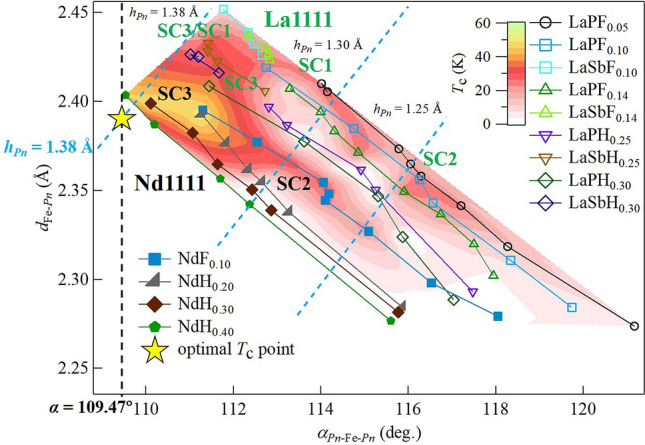
Contour plot of for RFe(As,P/Sb)(O,F/H) systems (R = La and Nd). Symbols P, Sb, F, and H represent P, Sb, F, and H substitution, respectively. For each As/P(Sb)-substitution system, the SC phases lie on a straight line directed from lower right to upper left in the order SC2, SC1 and SC3. Blue broken lines indicate constant values of pnictogen height from the Fe plane, , 1.30, and 1.38 Å. The black broken line shows the constant value of the Pn–Fe–Pn bond angle . The yellow star indicates the optimal local crystal structure point corresponding to a regular tetrahedron of Fe.
This figure indicates that the local crystal structure strongly affects the value in Fe-based superconductors. In SC3 phase where is close to 1.38 Å, is very high and insensitive to the band filling. Note that band filling should be another important parameter in weak coupling superconductivity where bosonic fluctuation via FS nesting acts as a pairing glue. In fact, in Fig. 6, the suppression due to electron doping is visualized by the white bands extending from upper left to lower right. Therefore, in SC2 phase (P-rich compositions), the FS-nesting condition is crucially important, which supports a weak coupling regime34–36. However, in the large region, there is no white area, namely, the FS-nesting condition does not affect at all.
One of the theoretical scenarios is derived from strong electron correlations near the Mott insulator regime16–18. In this scenario, the total electron correlation is strong enough to induce antiferromagnetic order in LaFeAsO. Then, superconductivity is realized when the carriers are doped in this strongly-correlated parent compound. The electron correlation is enhanced with increasing . Because can be controlled by As(Sb)/P, and Nd/La substitutions, the enhancement with these substitutions can be roughly interpreted as a result of increase in electron correlation. O/F(H) substitution has two effects, namely, carrier doping and increase in . The former weakens the electron correlation, while the latter strengthens it. The apparent separation of SC1 and SC3 in the La-system (Fig. 5a) is a result of the competition of these two effects. In Fig. 6, we can see that the electron correlation is enhanced towards the optimal point. T-linear resistivity observed in SC3 (Fig. 3) is a common property of strongly-correlated superconductors. Another strength of this model is that the electron correlation depends on the orbital, and the orbital plays a crucial role. This is consistent with the present results for SC1 and SC3.
There is another theoretical model for iron-based superconductors, shape resonance model19–23, where shows a clear enhancement around Lifshitz transition. In NdFeAsP(O,F), we observed the change of FS topology at Brillouin zone corner around –0.2, and that at zone center around –0.4 by angle-resolved photoemission spectroscopy measurement13, which may correspond to Lifshitz transition. However, the value changes gradually with x but does not show any abrupt change at a particular composition. So far, it is unclear whether this model can explain the observed complicated phase diagram in Fig. 5. Further experimental and theoretical studies are required to clarify that this model can be applied to the superconductivity mechanism of iron-based superconductors.
The evidence for the deviation from a weak coupling BCS regime can be seen in the so-called Uemura plot37. This famous plot demonstrates that many exotic superconductors, including cuprates, show a linear correlation between and muon relaxation rate that is proportional to the superconducting carrier density. The important fact here is that these superconductors are characterized by low carrier density and high , which suggests that the coupling interaction is extremely strong in these compounds, even beyond that of strong coupling superconductivity described by Eliashberg’s theory. Namely, they are beyond BCS superconductors, and may be close to BCS-BEC crossover. Shortly after the discovery of Fe-based superconductors, was determined for several RFeAs(O,F) (R = La, Nd and Ce) compounds38. All the data points for the measured compounds lie on the Uemura line, indicating that these compounds are categorized as strong coupling exotic superconductors beyond BCS theory.
On the other hand, for the low ( K) compound LaFePO was found to be comparable to that for other high ( K) compounds38. This means that the LaFePO data point in the – plot is far from the Uemura line. Recently, we performed systematic measurements of -values for various compounds of LaFeAsP(O,F), and found that with increasing As-content the data point approaches the Uemura-line39. This result implies that the coupling strength perhaps originating from electron correlation increases with increasing As-content, as we expect from this study, and as Misawa et al. predicted in their calculations16,18. Therefore, in the SC2 phase, the system changes from a weak coupling BCS superconductor to a strong coupling non-BCS one with increasing As-content, while SC1 and SC3 are in the latter regime. Note that the BCS–BEC crossover in multiband superconductors must exhibit properties different from the single band case, as has been theoretically studied for the application to iron-based superconductors40,41.
Conclusion
The electronic phase diagram was extensively investigated for RFeAs(P/Sb)O(F/H) (R = La and Nd) over a wide composition range. It was observed that the pnictogen height () increases with increasing As/Sb-composition and electron doping, and that in the Nd-system is larger than that in the La-system. The changes in the superconducting transition temperature () with composition can be understood in terms of the contribution of the hole Fermi surface (FS) and electron correlation strength, both of which are controlled by . The apparently-separated two superconducting phases (SC1 and SC3) in the La-system merged with Sb-substitution, suggesting that the origins of these two phases are the same. While FS nesting controlled by band filling plays an important role in the weak coupling BCS superconductivity for the P-rich compositions (SC2 phase), as increases with increasing As/Sb-content, superconductivity regime switches to strong coupling exotic one with orbital playing an important role (SC1/SC3), which may support the orbital-selective Mott scenario.
Methods
Polycrystalline RFeAs(P/Sb)OF (R = La and Nd) were synthesized using solid state reaction methods. For R = La, a stoichiometric-ratio mixture of LaAs, LaSb (or LaP), As (or P), FeO, Fe and LaF powder was pressed into a pellet in a pure Ar-filled glove box and heated at 1100–1250 for 40–60 h in an evacuated silica tube. For R = Nd, a mixture of NdAs, NdP, FeO, Fe and FeF powder was used for synthesis. As the solubility limit of fluorine is low (–0.20), hydrogen was used to synthesize heavily electron-doped samples (–0.40). H-substituted samples were synthesized under high pressure. Among the above powders, LaF and FeF were replaced by LaH and NdH for the La- and Nd-systems, respectively. A mixture of all the chemicals with the appropriate stoichiometric ratio was pressed into a pellet and heated at 1100 for 2 h under 4 GPa.
All the samples were characterized using high-resolution X-ray diffraction with beam energy of 11.5 keV and 15 keV at room temperature in BL-8A/8B of Photon Factory in KEK, Japan. The lattice constants, pnictogen (Pn) height from the Fe-plane (), Pn–Fe–Pn bond angle (), and Fe–Pn bond distance were calculated from the experimental data by Rietveld analysis42.
As, P, and Sb concentrations were determined by energy-dispersive X-ray (EDX) spectroscopy. In all samples, the estimated As-, P-, and Sb-concentrations were almost the same as the nominal values. We could not determine the F and H concentrations by EDX, because F and H are light elements.
Magnetic susceptibility measurements were performed using a Magnetic Property Measurement System (MPMS), with an applied field of 10 Oe. Electrical resistivity was measured using a standard four-probe method. Most of the -values presented here were those determined from zero resistivity.
Supplementary information
Acknowledgements
We thank H. Sagayama and R. Kumai for support with the X-ray diffraction measurements at KEK.
Author contributions
S.M. proposed the study and played a coordinating role. T.K., H.T., T.Y., M.U., A.T., and K.T.L. synthesized the samples and measured them. T.K., S.M., and S.T. discussed the results, and wrote the manuscript.
Competing interests
The authors declare no competing interests.
Footnotes
Publisher's note
Springer Nature remains neutral with regard to jurisdictional claims in published maps and institutional affiliations.
Supplementary information
The online version contains supplementary material available at 10.1038/s41598-021-89231-2.
References
- 1.Kamihara Y, et al. Iron-based layered superconductor: LaOFeP. J. Am. Chem. Soc. 2006;128:10012. doi: 10.1021/ja063355c. [DOI] [PubMed] [Google Scholar]
- 2.Kamihara Y, Watanabe T, Hirano M, Hosono H. Iron-based layered superconductor La[O1−xFx]FeAs (x = 0.05–0.12) with Tc = 26 K. J. Am. Chem. Soc. 2008;130:3296. doi: 10.1021/ja800073m. [DOI] [PubMed] [Google Scholar]
- 3.Jiang S, et al. Superconductivity up to 30 K in the vicinity of the quantum critical point in BaFe2(As1−xPx)2. J. Phys. Condens. Matter. 2009;21:382203. doi: 10.1088/0953-8984/21/38/382203. [DOI] [PubMed] [Google Scholar]
- 4.Kasahara S, et al. Electronic nematicity above the structural and superconducting transition in BaFe2(As1−xPx)2. Nat. 2012;486:382. doi: 10.1038/nature11178. [DOI] [PubMed] [Google Scholar]
- 5.Evtushinsky DV, et al. Propeller-like low temperature Fermi surface of Ba1−xKxFe2As2 from magnetotransport and photoemission measurements. J. Phys. Soc. Jpn. 2011;80:023710. doi: 10.1143/JPSJ.80.023710. [DOI] [Google Scholar]
- 6.Malaeb W, et al. Abrupt change in the energy gap of superconducting Ba1−xKxFe2As2 single crystals with hole doping. Phys. Rev. B. 2012;86:165117. doi: 10.1103/PhysRevB.86.165117. [DOI] [Google Scholar]
- 7.Liu C, et al. Importance of the Fermi-surface topology to the superconducting state of the electron-doped pnictide Ba(Fe1−xCox)2As2. Phys. Rev. B. 2011;84:020509. doi: 10.1103/PhysRevB.84.020509. [DOI] [Google Scholar]
- 8.Borisenko SV, et al. Superconductivity without nesting in LiFeAs. Phys. Rev. Lett. 2010;105:067002. doi: 10.1103/PhysRevLett.105.067002. [DOI] [PubMed] [Google Scholar]
- 9.Adachi T, et al. Electronic structure of Sr1−yCayFe2(As1−xPx)2 (x = 0.25, y = 008) revealed by angle-resolved photoemission spectroscopy. J. Phys. Soc. Jpn. 2019;88:084701. doi: 10.7566/JPSJ.88.084701. [DOI] [Google Scholar]
- 10.Suzuki H, et al. Strongly three-dimensional electronic structure and Fermi surfaces of SrFe2(As0. 65P0.35)2: Comparison with BaFe2(As1−xPx)2. Phys. Rev. B. 2014;89:184513. doi: 10.1103/PhysRevB.89.184513. [DOI] [Google Scholar]
- 11.Charnukha A, et al. Interaction-induced singular Fermi surface in a high-temperature oxypnictide superconductor. Sci. Rep. 2015;5:10392. doi: 10.1038/srep10392. [DOI] [PMC free article] [PubMed] [Google Scholar]
- 12.Nishi I, et al. Angle-resolved photoemission spectroscopy study of PrFeAsO0:7: Comparison with LaFePO. Phys. Rev. B. 2011;84:014504. doi: 10.1103/PhysRevB.84.014504. [DOI] [Google Scholar]
- 13.Takemori A, et al. Change of Fermi surface states related with two different Tc-raising mechanisms in iron pnictide superconductors. Phys. Rev. B. 2018;98:100501. doi: 10.1103/PhysRevB.98.100501. [DOI] [Google Scholar]
- 14.Yi M, et al. Observation of universal strong orbital-dependent correlation effects in iron chalcogenides. Nat. Commun. 2015;6:7777. doi: 10.1038/ncomms8777. [DOI] [PMC free article] [PubMed] [Google Scholar]
- 15.Maletz J, et al. Photoemission and muon spin relaxation spectroscopy of the iron-based Rb0.77Fe1.61Se2 superconductor: Crucial role of the cigar-shaped Fermi surface. Phys. Rev. B. 2013;88:134501. doi: 10.1103/PhysRevB.88.134501. [DOI] [Google Scholar]
- 16.Misawa T, Nakamura K, Imada M. Ab initio evidence for strong correlation associated with Mott proximity in iron-based superconductors. Phys. Rev. Lett. 2012;108:177007. doi: 10.1103/PhysRevLett.108.177007. [DOI] [PubMed] [Google Scholar]
- 17.de’Medici L, Giovannetti G, Capone M. Selective Mott physics as a key to iron superconductors. Phys. Rev. Lett. 2014;112:177001. doi: 10.1103/PhysRevLett.112.177001. [DOI] [PubMed] [Google Scholar]
- 18.Misawa T, Imada M. Superconductivity and its mechanism in an ab initio model for electron-doped LaFeAsO. Nat. Commun. 2014;5:5738. doi: 10.1038/ncomms6738. [DOI] [PubMed] [Google Scholar]
- 19.Kordyuk AA. Electronic band structure of optimal superconductors: From cuprates to ferropnictides and back again. Low Temp. Phys. 2018;44:477. doi: 10.1063/1.5037550. [DOI] [Google Scholar]
- 20.Pustovit YV, Kordyuk AA. Metamorphoses of electronic structure of FeSe-based superconductors. Low Temp. Phys. 2016;42:995. doi: 10.1063/1.4969896. [DOI] [Google Scholar]
- 21.Bianconi A. Shape resonances in superstripes. Nat. Phys. 2013;9:536. doi: 10.1038/nphys2738. [DOI] [Google Scholar]
- 22.Caivano R, et al. Feshbach resonance and mesoscopic phase separation near a quantum critical point in multiband FeAs-based superconductors. Supercond. Sci. Technol. 2008;22:014004. doi: 10.1088/0953-2048/22/1/014004. [DOI] [Google Scholar]
- 23.Bussmann-Holder A, et al. The road map toward room-temperature superconductivity: Manipulating different pairing channels in systems composed of multiple electronic components. Condens. Matter. 2017;2:24. doi: 10.3390/condmat2030024. [DOI] [Google Scholar]
- 24.Lee C-H, et al. Effect of structural parameters on superconductivity in fluorine-free LnFeAsO1−y (Ln = La; Nd) J. Phys. Soc. Jpn. 2008;77:083704. doi: 10.1143/JPSJ.77.083704. [DOI] [Google Scholar]
- 25.Mizuguchi Y, et al. Anion height dependence of Tc for the Fe-based superconductor. Supercond. Sci. Technol. 2010;23:054013. doi: 10.1088/0953-2048/23/5/054013. [DOI] [Google Scholar]
- 26.Kuroki K, Usui H, Onari S, Arita R, Aoki H. Pnictogen height as a possible switch between high-Tc nodeless and low-Tc nodal pairings in the iron-based superconductors. Phys. Rev. B. 2009;79:224511. doi: 10.1103/PhysRevB.79.224511. [DOI] [Google Scholar]
- 27.Miyasaka S, et al. Two fermi surface states and two Tc-rising mechanisms revealed by transport properties in RFeP1−xAsxO0.9F0.1 (R = La, Pr, and Nd) J. Phys. Soc. Jpn. 2013;82:124706. doi: 10.7566/JPSJ.82.124706. [DOI] [Google Scholar]
- 28.Lai KT, et al. Evolution of the phase diagram of LaFeP1−xAsxO1−yFy (y = 0–0.1) Phys. Rev. B. 2014;90:064504. doi: 10.1103/PhysRevB.90.064504. [DOI] [Google Scholar]
- 29.Miyasaka S, et al. Three superconducting phases with different categories of pairing in hole- and electron-doped LaFeAs1−xPxO. Phys. Rev. B. 2017;95:214515. doi: 10.1103/PhysRevB.95.214515. [DOI] [Google Scholar]
- 30.Ricci A. The microstrain-doping phase diagram of the iron pnictides: Heterostructures at atomic limit. J. Supercond. Nov. Magn. 2009;22:589. doi: 10.1007/s10948-009-0473-x. [DOI] [Google Scholar]
- 31.Gurvitch M. Universal disorder-induced transition in the resistivity behavior of strongly coupled metals. Phys. Rev. Lett. 1986;56:647. doi: 10.1103/PhysRevLett.56.647. [DOI] [PubMed] [Google Scholar]
- 32.Tin, Z. H. Doctor Thesis (Osaka University, 2020).
- 33.Usui H, Suzuki K, Kuroki K. Origin of the non-monotonic variance of Tc in the 1111 iron based superconductors with isovalent doping. Sci. Rep. 2015;5:11399. doi: 10.1038/srep11399. [DOI] [PMC free article] [PubMed] [Google Scholar]
- 34.Mazin II, Singh DJ, Johannes MD, Du MH. Unconventional superconductivity with a sign reversal in the order parameter of LaFeAsO1−xFx. Phys. Rev. Lett. 2008;101:057003. doi: 10.1103/PhysRevLett.101.057003. [DOI] [PubMed] [Google Scholar]
- 35.Kuroki K, et al. Unconventional pairing originating from the disconnected Fermi surfaces of superconducting LaFeAsO1−xFx. Phys. Rev. Lett. 2008;101:087004. doi: 10.1103/PhysRevLett.101.087004. [DOI] [PubMed] [Google Scholar]
- 36.Kontani H, Onari S. Orbital-fluctuation-mediated superconductivity in iron pnictides: Analysis of the five-orbital Hubbard–Holstein model. Phys. Rev. Lett. 2010;104:157001. doi: 10.1103/PhysRevLett.104.157001. [DOI] [PubMed] [Google Scholar]
- 37.Uemura YJ, et al. Basic similarities among cuprate, bismuthate, organic, Chevrel-phase, and heavy-fermion superconductors shown by penetration-depth measurements. Phys. Rev. Lett. 1991;66:2665. doi: 10.1103/PhysRevLett.66.2665. [DOI] [PubMed] [Google Scholar]
- 38.Carlo JP, et al. Static magnetic order and superfluid density of RFeAs(O, F) (R = La, Nd, Ce) and LaFePO studied by Muon spin relaxation: Unusual SIMILARITIES WITH THE BEHAVIOR OF CUPRATE superconductors. Phys. Rev. Lett. 2009;102:087001. doi: 10.1103/PhysRevLett.102.087001. [DOI] [PubMed] [Google Scholar]
- 39.Miyasaka, S. et al. In preparation.
- 40.Guidini A, Perali A. Band-edge BCS–BEC crossover in a two-band superconductor: Physical properties and detection parameters. Supercond. Sci. Technol. 2014;27:124002. doi: 10.1088/0953-2048/27/12/124002. [DOI] [Google Scholar]
- 41.Tajima H, Yerin Y, Pieri P, Perali A. Mechanisms of screening or enhancing the pseudogap throughout the two-band Bardeen–Cooper–Schrieffer to Bose–Einstein condensate crossover. Phys. Rev. B. 2020;102:220504. doi: 10.1103/PhysRevB.102.220504. [DOI] [Google Scholar]
- 42.Izumi F, Momma K. Three-dimensional visualization in powder diffraction. Solid State Phenom. 2007;130:15. doi: 10.4028/www.scientific.net/SSP.130.15. [DOI] [Google Scholar]
Associated Data
This section collects any data citations, data availability statements, or supplementary materials included in this article.



